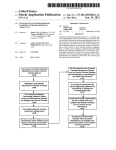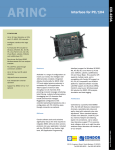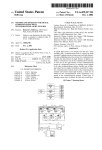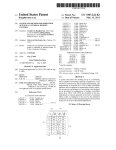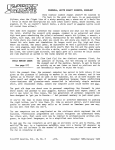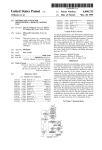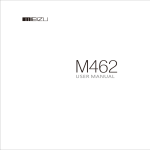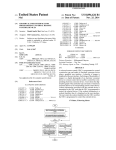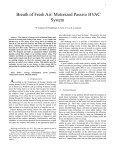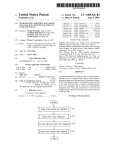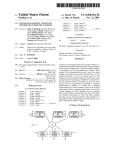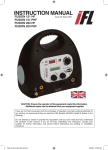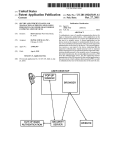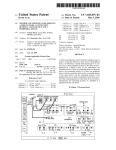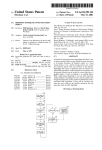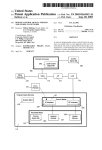Download Method and system to access software pertinent to an electronic
Transcript
US 20020083228A1 (19) United States (12) Patent Application Publication (10) Pub. No.: US 2002/0083228 A1 Chiloyan et al. (54) (76) (43) Pub. Date: METHOD AND SYSTEM TO ACCESS SOFTWARE PERTINENT TO AN ELECTRONIC PERIPHERAL DEVICE AT AN ADDRESS BASED ON A PERIPHERAL DEVICE IDENTIFIER (57) obtained from a peripheral device to determine a network address from a database, or generate the network address based on the identi?er. Information related to the peripheral device is obtained from a remote device at the network Inventors: John H. Chiloyan, Redmond, WA address. The method includes automatically transferring at least one identi?er from the peripheral device to a host device when the peripheral device is connected to the host Correspondence Address: device. The step of transferring is preferably done during or MICROSOFT CORPORATION LAW OFFICES OF RONALD M. ANDERSON 600 108TH AVENUE N.E., SUITE 507 after enumeration of the peripheral device, such as occurs when a USB device is connected to a computer. The identi?er is used as an index to automatically determine a BELLEVUE, WA 98004 (US) (51) (52) network address from a database on the host device or a 09/746,637 remote device, or to automatically generate a network address. Then, communication occurs between the host Dec. 21, 2000 device and a remote device or other source of the informa Publication Classi?cation device may download a device driver for the peripheral device from the remote device or from another peripheral device connected to the host device indicated by the network address. (21) Appl. No.: Filed: ABSTRACT Amethod and system for using a peripheral device identi?er (US); Edward C. Giaimo, Bellevue, WA (US) (22) Jun. 27, 2002 tion indicated by the network address. For example, the host Int. Cl.7 ..................................................... .. G06F 3/00 US. Cl. ............................................... .. 710/9; 709/226 61 60“ STORE NETWORK CONNECT DEVICE TO PORT @—> ADDRESSIN DATABASE BO 64 DON'T CORRECT SOFTWARE ACCESS OTHER INSTALLED? 'NFO FLAG : No NO 66 B2 DATABASE HAS NETWORK YES ADDRESS? i 68 84 ACCESS 70w NETWORK ADDRESS NO YES DATABASE HAS NETWORK l ADDRESS? AOOESS NETWORK ADDRESS MANUALLY OBTAIN SOFTWARE 72w OBTAIN SOFTWARE vIA NETWORK ADDRESS 76 ‘ 74M INSTALL ‘ SOFTWARE AccESS OTHER INFO vIA NETWORK ADD RESS LOAD SOFTWARE 78'” INTO MEMORY aim Q Patent Application Publication Jun. 27, 2002 Sheet 2 0f 8 60* STORE NETWORK @_—> 6‘ US 2002/0083228 A1 CONNECT DEVICE TO PORT ADDRESS IN DATABASE ENUMERATE DEVICE 64 DON'T ACCESS OTHER CORRECT SOFTWARE YES > INFO FLAG = INSTALLED? TRUE? NO NO 66 82 DATABASE HAS NETWORK YES ADDRESS? 1 NO AOOESS NETWORK ADDRESS 84 YES \ i DATABASE HAS NETWORK ADDRESS? AOOESS NETWORK ADDRESS NO 68 l IvIANuALLY 1"" “ OBTAIN I P523528 SOFTWARE v YES OBTAIN 72'» SOFTWARE vIA NETWORK ADDRESS 76 i 74w ‘ INSTALL SOFTWARE _ ' ACCESS OTHER INFO vIA NETWORK ADDRESS ‘ LOAD SOFTWARE FIG. 2 78*“ —> INTO MEMORY END ‘ Patent Application Publication Jun. 27, 2002 Sheet 3 0f 8 US 2002/0083228 A1 CHECK LOCAL 90w DATABASE FOR NETWORK ADDRESS 92 NO l LOCAL DATABASE HAS NETWORK ‘DDRESS’P ACCESS WINDOWS® 100w UPDATE SITE YES 9x REMOTE DATABASE HAS NETWORK YES——> 7 READ NETWORK ADDRESS ‘ DDRESS'? NO 96 T r SET STEP 66 104w RESULT TO "NO" I SET STEP 66 RESULT TO "YES" CONTINUE TO MANUAL LOAD STEP 68 CONTINUE TO AUTO ACCESS STEP 7O FIG. 3 Patent Application Publication Jun. 27, 2002 Sheet 4 0f 8 US 2002/0083228 A1 1 10 PC POWERED UP WITH DEVICE ATTACHED USER "HOT CONNECTS" DEV|CE I BUS DRIVER NOTIFY PNP 114w MGR OF NEW DEVICE \ PNP MGR 116w ENUMERATE DEVICE PNP MGR 118 CHECK DEVICE 'V REGISTRY V PNP MGR 120w IE8 PNP MGR 124w LOAD OLD DEVICE DRIVER \ DEVICE-URI DLL 126” ACTIVATE BROWSER WITH URI I DEVICE INSTALLED? Nf PNP MGR LOAD NEW \1122 DEVICE DRIVER Patent Application Publication Jun. 27, 2002 Sheet 5 0f 8 US 2002/0083228 A1 PNP MGR 130m, SAVE DEVICE DATA IN REGISTRY r PNP MGR EXECUTE 132“ NEW-DEVICE DLL V NEW-DEVICE DLL 134m LOAD DEVICE DATA FROM REGISTRY 7 ‘I38 NEW-DEVICE DLL I NEW-DEVICE DLL? , DISPLAY URITO I USER '| DATABASE " 1 7 ?EvT/bEvIEEbIE " I L. _ _ _ _ _ _ I I L, _ _ _ _ YES HAS DEVICE URI? 140 _ _I NEW-DEVICE DLL USER ACTIVATE ACTIVATES \“—YES——> BROWSER WITH II NEW-DE\7ICE DLL COMPLETE ‘' DEVICE INSTALLATION r PNP MGR 146 f\, LOAD DEVICE DRIVER V FIG. 5 I RETURN I f144 Patent Application Publication Jun. 27, 2002 Sheet 6 0f 8 US 2002/0083228 A1 PNP MGR 150w DEVICE URI II\I DATABASE '2 152 154 YES V 1 PNP MGR PNP MGR EXECUTE +YESJ DEVICE-URI DLL DOW ASK FLAG = FALSE? —NO-> 7 DEVICE-URI DLL 156 A, PROMPT USER Y 158 DEvIcE-URI DLL 1 NO DON’T ASK YES SELECTED? 160 "“NO 162 \ l DEVICE-URI DLL i / DEvIcE-URI DLL SET DON’T ASK = SET DON’T ASK = TRUE FALSE L I i DEvIcE-URI DLL 164 \, USER ~ YES 166 l WANTS URI No > ACTIVE? DEvIcE-URI DLL ACTIVATE BROWSER WITH ~ FIG-6 Patent Application Publication Jun. 27, 2002 Sheet 7 0f 8 170 USER RUNS DEVICE MANAGER USER REQUESTS DEVICE PROPERTIES DEVICE MGR 174w BEGIN DISPLAY OF DEVICE PROPERTY SHEET 7 DEVICE MGR 176w URI IN DATABASE’? YES I DEVICE MGR CREATE URI PROPERTY PAGE ‘ DEVICE MGR 180w CREATE SYSTEM AND VENDOR PROPERTY PAGES FIG. 7 r I CONTINUE I US 2002/0083228 A1 Patent Application Publication Jun. 27, 2002 Sheet 8 0f 8 US 2002/0083228 A1 Jun. 27, 2002 US 2002/0083228 A1 METHOD AND SYSTEM TO ACCESS SOFTWARE PERTINENT TO AN ELECTRONIC PERIPHERAL DEVICE AT AN ADDRESS BASED ON A PERIPHERAL DEVICE IDENTIFIER FIELD OF THE INVENTION [0001] The present invention generally relates to a method and system for accessing software and other materials pertaining to a peripheral device over a network, and more speci?cally, to accessing such softWare and other pertinent materials using a netWork address that is stored in a database or generated, the netWork address being associated With an identi?er for the peripheral device. BACKGROUND OF THE INVENTION [0002] Most personal computers and many other types of computing devices such as game consoles, TV set-top boxes, industrial control equipment, and automotive equipment are designed to connect to different peripheral devices that eXpand the functionality of the computing device. Peripheral devices and computing devices typically employ communi cation standards that enable the host device to recogniZe the presence and identity of a connected peripheral device. These communication standards facilitate plug-and-play, Which enables a computing device to automatically recog niZe a peripheral device and assign all of the resources that it requires Without manual intervention. While older legacy personal computer peripheral devices and earlier versions of computer operating systems did not implement the conve nience of plug-and-play, most peripheral devices currently sold for use With personal computers are plug-and-play compatible. In addition, neWer personal computers and neWer operating systems noW being sold and many neWer designs of peripheral devices provide for “hot” connection or disconnection of a Universal Serial Bus (USB) peripheral device While the computer is energiZed. For eXample, many computers and peripheral devices support the USB standard and have USB interfaces Which provide for “hot” connection device thus detracts from a quality user experience, because the initial installation of the peripheral device is not truly a “plug-and-play” operation. [0004] Typically, When a neW peripheral device is con nected to a computer, the computer operating system detects the presence of the neW peripheral, and then requests the user to insert the CD-ROM or other medium supplied With the peripheral device. Users are accustomed to this delay incurred before using a neW product, but Would clearly prefer to avoid it. Similarly, manufacturers of peripheral devices Would prefer not to include CD-ROMs or ?oppy disks With their products, because of the costs involved. Producing and distributing CD-ROMs or other memory media shipped With a peripheral device represents a consid erable eXpense to peripheral vendors for at least tWo reasons. One reason is the obvious cost of materials and packaging associated With providing tangible medium, such as CD ROMs. In addition, scheduling production of CD-ROMs or ?oppy disks can delay shipment of the peripheral devices, or reduce the amount of softWare development time available. If changes to the device driver or other softWare that Will be shipped With a neW peripheral device are required late in the development cycle of the product, then CD-ROM produc tion may be delayed until after hardWare production of the peripheral is already complete. Besides delaying delivery of the peripheral devices, storing the completed peripheral devices in inventory While the CD-ROMs or ?oppy disks are being produced adds cost and delays revenue generation. Alternatively, to ensure CD-ROM and/or ?oppy disk pro duction meets the eXpected peripheral hardWare production and shipping schedules, softWare development may be cut short and development of additional features that might make the overall peripheral product more competitive and attractive in the marketplace may not occur. Vendors may even have to distribute updated softWare on another CD ROM, or by other means, to correct bugs in the softWare or improve the functionality of softWare materials previously shipped With peripheral devices sold. or disconnection. Speci?cally, When a neWly connected USB [0005] Updated device drivers and other materials are often available via the Internet, and many computers have device is enumerated by the operating system, a vendor identi?cation (ID), a product ID, and other information are obtained from the peripheral device in device descriptor ?elds. Assuming that a USB-compliant peripheral device the Internet. Thus, a peripheral vendor doesn’t necessarily either full-time connections or at least a dialup connection to Was previously installed on the computer (i.e., listed in a have to supply a CD-ROM or ?oppy disks With a peripheral device if a vendor instead requires users to obtain the materials by a doWnload over the Internet. HoWever, con device registry and provided With an appropriate device necting to the Internet and/or doWnloading drivers and other driver), the computer can immediately begin using the peripheral device. materials is also a manual process that must be carried out by the user, and Will normally require the user to enter an appropriate address for a manufacturer Web site, and then [0003] Currently, When a peripheral device is connected to a computer or other host device for the very ?rst time, it is at times necessary to run a setup program to install any client application softWare used in connection With the peripheral device and to provide a driver for the peripheral device. Typically, a peripheral device driver and related application softWare are provided on a CD-ROM or ?oppy disk that is packaged With the peripheral device. Drivers for peripheral devices are not alWays provided With the operating system, particularly for peripheral devices sold after the operating system Was released for sale. When a driver is not included With the operating system, a user must manually load or search through various Web pages until the appropriate Web page is found to enable the doWnload to occur. Such a manual process can be dif?cult for novice users, can delay the initial installation of a peripheral on a computer, and likely detracts from user satisfaction. Furthermore, a fre quent problem With peripheral devices being reinstalled on a host computing device is that the user Will have misplaced the CD-ROMs or ?oppy disks that Were originally provided With the peripheral devices. Unless device drivers can be obtained from another source, it may not be possible to reinstall a peripheral device. otherWise manually provide the driver, application softWare, [0006] A novel alternative addressing these problems is and/or other material for the peripheral device. The interac tion required by the user to initially install a peripheral for the peripheral manufacturer to provide a netWork address in a memory of the peripheral device for a site from Which Jun. 27, 2002 US 2002/0083228 A1 a device driver and/or other information pertinent to the peripheral device can be obtained. This alternative is dis closed in commonly assigned US. patent application, entitled “Method and System to Access Software Pertinent to an Electronic Peripheral Device Based on an Address Stored in a Peripheral Device,” Ser. No. , ?led on , 2000. In this alternative, the operating system reads the address from the peripheral device When the peripheral device is ?rst connected to a host computing device, or When the host computing device is energiZed With the peripheral device connected to the host computing device for the ?rst time. The operating system then auto matically doWnloads the driver and/or other material from a other automatic means. Alternatively, the user may manually notify the host device of the connection. [0010] The step of transferring the identi?er from the peripheral device is preferably accomplished during an enumeration process performed by the operating system When a peripheral device is connected to a computer. During the enumeration process the operating system queries a neWly connected peripheral device to determine parameters of the peripheral device, such as those in a USB device descriptor. The device descriptor includes information such as a vendor identi?er and a product identi?er. The step of address. HoWever, this approach requires that the peripheral transferring the identi?er from the peripheral device may also be performed after enumeration using functions that request and receive the device descriptor. device store an address. Since peripheral devices currently do not store such a netWork address, existing or legacy peripheral devices could not utiliZe this novel alternative. [0011] If the desired peripheral device identi?er is an identi?er other than those in the device descriptor, other functions may be used to request and receive the identi?er, [0007] or an index thereto. For example, a string descriptor may matically providing a netWork address for a site from Which materials pertaining to a peripheral device that is connected to a host computing device can be obtained. Currently, there is no provision for accomplishing this function. The method should also avoid the need for substantial user manual interaction to load device drivers and install related softWare When connecting a peripheral device to a host computing of the peripheral device at Which the identi?er is stored. Alternatively, a class request may be issued to the peripheral device for the identi?er. As another alternative, a vendor speci?c command or different command may be issued to obtain the identi?er from the peripheral device. Web server or remote device accessed using the Internet It Would thus be desirable to provide another method applicable to existing peripheral devices, for auto device. Clearly, a system and method providing automated access over a netWork to the required drivers and other related softWare, for both neW and older peripheral devices, Will avoid the problems noted above. SUMMARY OF THE INVENTION encode an identi?er, or a pointer to a location in a memory [0012] The method also preferably includes the step of checking to determine Whether the peripheral device Was previously registered on the host device. If not, the step of looking for a netWork address in a database, or the step of generating a netWork address based on the peripheral device identi?er is carried out. Alternatively, this check can be done after the host device has already determined the netWork address. In this case, the operating system decision deter [0008] The present invention is directed to a method and system for using at least one peripheral device identi?er mines Whether to launch a task to access the netWork obtained from a peripheral device to determine a netWork information, and/or perform any other task related to access address, or to retrieve and install a device driver and/or other address stored in a database, or generated by an algorithm. ing the netWork address. A remote device at the netWork address is accessed to obtain [0013] The step of determining a netWork address prefer information related to the peripheral device. The method includes the step of transferring at least one identi?er from the peripheral device to a host device. A netWork address is then automatically determined by the host device based on ably includes the step of searching a database based on the identi?er. The database may reside on the host device or at the remote device. Alternatively, the identi?er can be used to the identi?er, enabling communication pertaining to the generate a netWork address that includes the identi?er, or is otherWise based on the identi?er. peripheral device to occur betWeen the host device and a remote device, or other additional source, at the netWork address. For example, the host device may doWnload a host device and remote device preferably includes the step device driver for the peripheral device from the remote device. The method thus also preferably includes at least one of the steps of retrieving softWare and/or other material from the remote device at the netWork address, automatically executing a program, installing a device driver, installing an application program, displaying a Web page, registering a product, doWnloading documentation, doWnloading and installing ?rmWare into the peripheral device, presenting help information, or accessing other material related to the peripheral device—all from the remote device accessed using the netWork address. Those skilled in the art Will recogniZe that any number of items can be obtained and/or performed once the netWork address is determined from the peripheral device identi?er. [0009] The host device may detect When a peripheral device is neWly connected to the host device by detecting a change in the number of peripheral devices connected, or by [0014] The step of enabling communication betWeen the of automatically retrieving data, machine instructions, a document, or other machine-readable material pertaining to the peripheral device from the remote device at the netWork address. Preferably, the method further includes the step of executing a setup program stored on the remote device that pertains to the peripheral device. The setup program can automatically install a device driver program for the periph eral device on the host device, automatically execute an application program pertaining to the peripheral device, and/or provide a link to the netWork address that a user can subsequently select to again connect to the remote site. [0015] The method preferably further includes the step of automatically executing a broWser function on the host device and automatically accessing the netWork address. Alternatively, the method includes the step of requesting permission of a user to execute a broWser function on the host device in order to automatically access the netWork Jun. 27, 2002 US 2002/0083228 A1 address. This step optionally includes the step of enabling a to a URI obtained from a database to obtain information user to suppress further requests to execute a browser pertaining to a peripheral device; function on the host device and/or to automatically access the netWork address. [0016] Another aspect of the present invention is directed to a system for automatically accessing information related to a peripheral device. The system includes the peripheral device storing at least one identi?er. One embodiment of the system also comprises a host device, such as a personal computer, that includes a memory, a netWork interface, a processor, and an interface used for connecting With the peripheral devices. The host device connects in communi [0025] FIG. 7 is a How diagram illustrating the logic employed for creating a peripheral device property page that includes a URI for display and activation by a user to subsequently access the remote site indicated by the netWork address; and [0026] DESCRIPTION OF THE PREFERRED EMBODIMENT cation With a remote device over the netWork interface or via a peripheral interface. Preferably, the remote device is a server, but alternatively, it can comprise a non-volatile storage in Which a database of netWork addresses is stored. The database of netWork addresses is employed to identify a netWork address for the remote device, based on an identi?er obtained from the peripheral device, enabling information pertinent to the peripheral device, such as a device driver, to be obtained by the host device from the remote device. Alternatively, the remote device may be another peripheral device, such as an external storage device. The remote device can comprise another peripheral device, Which may be useful for industrial, automotive, and other closed systems. In any case, the host device accesses the remote device using the netWork address to obtain data, machine instructions, a document, and/or other material pertaining to the peripheral device. [0017] Another aspect of the present invention is directed FIG. 8 is a schematic block diagram of an exem plary personal vehicle assistant (PVA) system suitable for implementing the present invention. [0027] Exemplary Operating Environment [0028] FIG. 1 and the folloWing discussion are intended to provide a brief, general description of a suitable computing environment in Which the present invention may be imple mented, both in regard to a server that stores and provides Web pages and a client that requests the Web pages and displays them to a user. Although not required, the present invention Will be described in the general context of com puter-executable instructions, such as program modules that are executed by a personal computer. Generally, program modules include routines, programs, objects, components, data structures, etc. that perform particular tasks or imple ment particular abstract data types. Moreover, those skilled in the art Will appreciate that this invention may be practiced With other computer system con?gurations, particularly in regard to a client device for displaying a Web page, includ a machine-readable medium on Which are stored ing hand-held devices, pocket personal computing devices, machine-executable instructions that, When executed by a processor, generally cause the processor to perform the steps of the method described above. digital cell phones adapted to connect to a netWork, micro processor-based or programmable consumer electronic BRIEF DESCRIPTION OF THE DRAWING FIGURES mainframe computers, industrial control equipment, auto motive equipment, aerospace equipment, and the like. The invention may also be practiced in distributed computing environments Where tasks are performed by remote process to [0018] The foregoing aspects and many of the attendant advantages of this invention Will become more readily appreciated as the same becomes better understood by reference to the folloWing detailed description, When taken in conjunction With the accompanying draWings, Wherein: [0019] FIG. 1 is a schematic block diagram of an exem plary personal computer (PC) system suitable for imple menting the present invention; [0020] FIG. 2 is a How diagram illustrating the logic of a preferred embodiment of the invention; [0021] FIG. 3 is a How diagram illustrating the logic of an embodiment for determining Whether a netWork address, corresponding to a particular peripheral device, is stored in a database; [0022] FIG. 4 is a How diagram illustrating the logic of an devices, game consoles, TV set-top boxes, multiprocessor systems, netWork personal computers, minicomputers, ing devices that are linked through a communications net Work. In a distributed computing environment, program modules may be located in both local and remote memory storage devices. [0029] With reference to FIG. 1, an exemplary system for implementing the present invention includes a general pur pose computing device in the form of a conventional per sonal computer 20, provided With a processing unit 21, a system memory 22, and a system bus 23. The system bus couples various system components, including the system memory, to processing unit 21 and may be any of several types of bus structures, including a memory bus or memory controller, a peripheral bus, and a local bus using any of a variety of bus architectures. The system memory includes read-only memory (ROM) 24 and random access memory embodiment that accesses a netWork address from a data (RAM) 25. Abasic input/output system (BIOS) 26, contain base using an identi?er for the peripheral device; ing the basic routines that help to transfer information betWeen elements Within the personal computer 20, such as during start up, is stored in ROM 24. The personal computer [0023] FIG. 5 is a How diagram illustrating the logic of an embodiment that doWnloads a neW device driver for a FIG. 6 is a How diagram illustrating the logic of an 20 further includes a hard disk drive 27 for reading from and Writing to a hard disk (not shoWn), a magnetic disk drive 28 for reading from or Writing to a removable magnetic disk 29, and an optical disk drive 30 for reading from or Writing to embodiment that activates a broWser function and navigates a removable optical disk 31, such as a CD-ROM or other peripheral device from a Uniform Resource Indicator (URI) obtained from a database; [0024] Jun. 27, 2002 US 2002/0083228 A1 optical media. Hard disk drive 27, magnetic disk drive 28, and optical disk drive 30 are connected to system bus 23 by a hard disk drive interface 32, a magnetic disk drive inter face 33, and an optical disk drive interface 34, respectively. The drives and their associated computer-readable media provide nonvolatile storage of computer-readable machine some other common netWork node, and typically includes many or all of the elements described above in connection With personal computer 20, although only an external memory storage device 50 has been illustrated in FIG. 1. The logical connections depicted in FIG. 1 include a local instructions, data structures, program modules and other area netWork (LAN) 51 and a Wide area netWork 52. Such netWorking environments are common in offices, data for personal computer 20. Although the exemplary enterprise-Wide computer netWorks, intranets, and the Inter environment described herein employs a hard disk, remov net. able magnetic disk 29, and removable optical disk 31, it Will be appreciated by those skilled in the art that other types of computer-readable media, Which can store data that is acces sible by a computer, such as magnetic cassettes, ?ash memory cards, digital video disks, Bernoulli cartridges, random access memories (RAMs), read-only memories (ROMs), and the like, may also be used in the exemplary operating environment. [0030] [0032] When used in a LAN netWorking environment, personal computer 20 is connected to LAN 51 through a netWork interface or adapter 53. When used in a WAN netWorking environment, personal computer 20 typically includes a modem 54, or other means for establishing communications over WAN 52, such as the Internet. Modem 54, Which may be internal or external, is connected to system bus 23, or coupled to the bus via I/O device interface 46, i.e., A number of program modules may be stored on through a serial port. In a netWorked environment, program the hard disk, magnetic disk 29, optical disk 31, ROM 24 or RAM 25, including an operating system 35 (With a broWser modules depicted relative to personal computer 20, or por tions thereof, may be stored in the remote memory storage device. It Will be appreciated that the netWork connections function), one or more application programs 36, other pro gram modules 37, and program data 38. A user may enter commands and information into personal computer 20 through input devices such as a keyboard 40 and a pointing device 42. Other input devices (not shoWn) may include a microphone, joystick, game pad, satellite dish, scanner, digital camera, or the like. These and other input devices are often connected to processing unit 21 through an input/ output (I/O) device interface 46 that is coupled to the system bus. Output devices, such as a printer (not shoWn), may also be connected to processing unit 21 through an I/O device interface 46 that is coupled to the system bus. Similarly, a monitor 47 or other type of display device is also connected to system bus 23 via an appropriate interface, such as a video adapter 48, and is usable to display Web pages and/or other information. In addition to the monitor, personal computers are often coupled to other peripheral output devices (not shoWn), such as speakers (through a sound card or other audio interface—not shoWn). Such I/O devices are generally referred to as peripheral devices. For purposes of discussion in regard to the present invention, general peripheral device 56 is coupled to personal computer 20 via I/O device interface 46. The term I/O device interface is intended to encompass each interface speci?cally used for a serial port, a parallel port, a game port, a keyboard port, and/or a USB shoWn are exemplary and other means of establishing a communications link betWeen the computers may be used, such as Wireless communication and Wide band netWork links. [0033] Exemplary Implementation of the Present Inven tion [0034] The folloWing describes exemplary implementa tions of preferred embodiments utiliZing plug-and-play tech nology, such as USB standards for communication betWeen a personal computer 20 (shoWn in FIG. 1), acting as a host device, and a peripheral device, such as an input, output, or other device. Those skilled in the art Will recogniZe that the details may be modi?ed slightly for non-plug-and-play technologies and other forms of communication With periph eral devices, such as RS-232C serial, IEEE 1284 parallel, IrDA infrared, IEEE 1394 and other standards. HoWever, USB Will be used consistently in the folloWing examples to simplify the discussion. [0035] FIG. 2 illustrates the logic of an embodiment that installs a device driver, application softWare, or other mate rial. Installing a device driver Will be the primary example. At a step 60 a netWork address is stored in a database. port. Through I/O device interface 46, information is com municated betWeen peripheral device 56 and processing unit 21 via system bus 23. Peripheral device 56 includes ?rm Preferably, this netWork address identi?es a location Where the device driver and/or other material can be accessed. Ware memory 58 for storing information. FirmWare memory ti?es a central location Where a different address can be 58 may be erasable programmable read-only memory (EPROM), ?ash memory, magnetic storage, or other obtained, Which identi?es a location from Which the device driver and/or other material is doWnloaded. Those skilled in the art Will recogniZe that address redirection and/or branch memory. FirmWare memory 58 stores a vendor ID, a product ID, and/or other information related to the peripheral device 56. [0031] Personal computer 20 may operate in a netWorked environment using logical connections to one or more additional sources, such as a remote computer 49. In regard to the present invention, the URI or address stored in the ?rmWare memory of the peripheral device may specify a location that is accessed through remote computer 49. Remote computer 49 may be another personal computer, a HoWever, in another embodiment, the netWork address iden ing can be extended further to create a series of successive links to a ?nal terminal location Where the device driver and/or other material is located and can be obtained. In one preferred embodiment, the terminal netWork address is stored in a database on host personal computer 20. HoWever, as indicated above, another embodiment of the present invention stores the terminal netWork address in a database on an additional source, such as remote computer 49 (shoWn in FIG. 1). server (Which is typically generally con?gured much like [0036] personal computer 20), a router, a netWork personal com puter, a peer device, another peripheral device, a satellite, or a USB I/O device interface 46 (shoWn in FIG. 1). Alterna At a step 61 a user connects a peripheral device to tively, step 61 may represent poWer being applied to host Jun. 27, 2002 US 2002/0083228 A1 personal computer 20 With a peripheral device already connected. In yet another alternative, step 61 may not refer to a direct physical connection, but instead, to a remote or virtual connection, such as Would occur by bringing a peripheral device that communicates over a Wireless con nection Within infrared, radio frequency (RF), or other appropriate communication distance of host personal com puter 20, depending upon the nature of the Wireless com munication implemented betWeen the host computer and the peripheral device. Returning to a preferred USB embodi ment, operating system 35 (shoWn in FIG. 1) detects and enumerates the neW device at a step 62. During the enu meration process, operating system 35 queries the peripheral device for a device descriptor. The device descriptor pref erably contains data ?elds relating to the peripheral device, including a vendor ID and a product ID. [0037] Once these IDs are parsed from device descriptor ?elds, the netWork address can be determined from a data base, or alternatively, can be generated based upon the IDs. In one embodiment, operating system 35 ?rst determines at a decision step 64 Whether a device driver and/or other softWare is already available on host personal computer 20. The operating system Will typically check for the device driver among the system ?les in a prede?ned directory. [0038] If the device driver and/or other softWare is already available on host personal computer 20, then operating system 35 simply loads the device driver and/or other softWare into memory 22 (shoWn in FIG. 1). Optionally, operating system 35 can perform a more detailed check by comparing IDs obtained from the device descriptor ?elds to Internet, or folloWing another procedure that requires user intervention or action. Manual loading may also be required if netWork communication is not available or if it is inactive. HoWever, if a netWork address is stored in the database, then operating system 35 performs a step 70 to access the netWork address. [0041] After accessing the netWork address via the net Work connection, e.g., a Web page on a Web server as speci?ed by the netWork address accessed over a connection to the Internet, operating system 35 performs a step 72 to initiate doWnload of the device driver and/or other softWare from a remote device at the netWork address. Again, if netWork communication is not available or not active, then the attempt to initiate doWnload Will fail, and manual intervention is required to load the device driver and/or other softWare. Preferably, hoWever, netWork communication is available/active and doWnloading of the softWare and any other materials is accomplished by a ?le transfer request via hypertext transfer protocol (HTTP), ?le transfer protocol (FTP), Wireless application protocol (WAP), or other com munication technique. [0042] Once received, the device driver and/or other soft Ware is installed on the host personal computer at a step 74. Installation may be completely automatic, or may be accom plished by a WiZard program. When a driver or other material is ?rst doWnloaded, it is preferred that a step 76 be performed to access other information relevant to the periph eral device at the site speci?ed by the netWork address. For eXample, a vendor offer for additional equipment, supplies, or services can thus be displayed to a user. Finally, the device driver or other material is loaded into memory 22 at the existing device driver and/or other softWare to see if the version numbers match or if the available version number is later than the version number referenced in the device descriptor ?elds. If the version numbers match or the avail able version is a more recent one, then operating system 35 loads the device driver and/or softWare into memory 22. [0043] If at decision step 66, the correct device driver or other softWare is already installed on the host personal computer, then a further series of steps might be undertaken [0039] If the version numbers do not match, or if the available version is older, or if the device driver and/or other softWare is not even available on personal computer 20, then operating system 35 performs a decision step 66 to deter mine Whether a corresponding netWork address is stored in the database. Further details of steps folloWed for making this determination are described beloW With regard to FIG. eXample, the peripheral device vendor may desire that an advertising Web page be displayed, or that other services be offered to the user, on the hope of generating further sales. HoWever, it is also contemplated that the user Will be given the option to suppress such additional displays or offers of products or services. Thus, a decision step 80 checks Whether a ?ag has been set by the user to prevent any further 3. Alternatively, the netWork address is generated from the IDs. For eXample, the identi?er ?elds of the device descrip the method goes directly to step 78 to load the driver a step 78, and the peripheral device is ready for use. to access the netWork address for other purposes. For attempts to access information at the netWork address. If so, tor can be mapped to an Internet Protocol (IP) address. softWare or other softWare. If, hoWever, the ?ag is false, i.e., Speci?cally, the device class is used for the ?rst quad of the IP netWork address, the device subclass is used for the second quad, the product ID is used for the third quad, and the product ID is used for the fourth quad of the IP netWork address. Another approach is to generate an alphanumeric not set by the user, then the method proceeds to a decision step 82 to connect to the netWork address, or alternatively, to generate the netWork address. If no netWork address is found in the database and it cannot be generated from the peripheral device ID information, then operating system 35 Web address from the vendor ID name and the product ID optionally processes an error at a step 86 and continues to model, e.g., WWW.<vendorIDname>.com/<modelIDname>/ support. step 78 to load the softWare into memory. If a netWork address is found in a database, or has been generated based on the IDs, then the netWork address is accessed at a step 84 [0040] If a netWork address is not stored in the database, or cannot be generated properly using the device descriptor ?elds, then the device driver and/or other softWare must be manually loaded at a step 68, as shoWn in FIG. 2. Manual to obtain the other information noted at step 76. Again, the device driver or other previously installed softWare is loaded into memory 22 at step 78. loading typically involves inserting a storage medium, such [0044] With respect to FIG. 3, a preferred embodiment is as a CD-ROM, on Which the device driver and/or softWare illustrated for determining Whether a netWork address related to a particular peripheral device is stored in a are stored, into a corresponding drive, or manually doWn loading the device driver and/or other softWare via the database. During enumeration step 62 in FIG. 2, operating Jun. 27, 2002 US 2002/0083228 A1 system 35 requests from the peripheral device a device descriptor that includes vendor and product IDs. At a step 90, operating system 35 then checks a local database for a netWork address, based on the identi?ers. The database may be a part of the operating system ?les previously installed on the host personal computer and Will then likely be updated from time to time, during periodic online updates of the operating system. The vendor ID and/or product ID Will serve as indexes into the database to reference a netWork address related to the peripheral device. If at a decision step parameters. The detailed enumeration tasks are carried out by the Bus Driver program in partnership With the Plug and-Play Manager program. [0047] The Bus Driver program is typically a peripheral component interconnect (PCI) or personal computer memory card international association (PCMCIA) parent bus driver module. This enumeration process is similar to that described earlier, in that the Plug-and-Play Manager gathers information from the peripheral device, such as the vendor ID and product ID. Alternatively, the ID information 92, operating system 35 determines that the local database is obtained via a class driver or vendor speci?c device includes a netWork address based on the IDs obtained from (VSD) request. Also, the strings of ID information can alternatively be obtained directly from a knoWn memory the peripheral device, then operating system 35 reads the netWork address into memory 22 of the host personal computer (or other host device) at a step 94. In this case, the result of the determination (of step 66) is set to “YES” at a step 96. With this result, the overall installation process continues With the automatic loading that occurs over the netWork at step 70. [0045] If, hoWever, no local database exists on the host personal computer or other host device, or if the local database does not include a netWork address indexed by the IDs obtained from the peripheral device, then the operating location in the peripheral device or from a location in the memory of the peripheral device that is indicated by a pointer obtained from the peripheral device. Encoding Within the strings obtained from the peripheral device can distinguish the various types of information. For example, a forWard slash symbol can be used to indicate a speci?c type of information or a command to treat the folloWing charac ters as a speci?c type of information. Speci?cally, a slash T (/T) could indicate that the folloWing characters are a title or text to display. Aslash I (/I) could indicate instructions to the operating system. Aslash S (/S) could indicate another string system accesses a remote database at a step 100. The remote identi?er. As before, the characters folloWing one of these database may be accessed at a prede?ned Microsoft Corpo ration WINDOWS® Update Web site, or at a different address indicating some other remote device With Which communication is provided over the netWork. A decision in quotation marks, or a pointer to a memory location Where the string characters are stored. step 102 determines Whether a network address, indexed by the IDs obtained from the peripheral device, is stored in the remote database. This step may be accomplished by a request from operating system 35 directly to the remote database, or by a different remote database access procedure, as appropriate for the remote database. For example, the commands could be the actual string, for example, enclosed [0048] Having obtained the peripheral device IDs and any other parameters from the peripheral device, the Plug-and Play Manager examines a registry of previously installed peripheral devices at a step 118. At a decision step 120, the Plug-and-Play Manager determines Whether the neWly con nected peripheral device has been previously installed. If remote database can be queried via an active server page not, the Plug-and-Play Manager executes an operation at a step 122 to load a neW device driver. Conversely, if the (ASP) or other server process. Those skilled in the art Will peripheral device has been previously installed, the Plug recogniZe that a netWork address could alternatively be generated at the remote device, based upon the IDs obtained from the peripheral device. If a netWork address is found in the remote database, or remotely generated, then the net Work address is transferred to the host personal computer (or other host device) and stored in memory 22 at step 94. If, and-Play Manager loads the old device driver at a step 124. As discussed above, the Plug-and-Play Manager can still use the IDs obtained from the peripheral device to determine a URI and execute a Device-URI dynamic link library (DLL) hoWever, no remote database exists, or if the remote data base does not include a netWork address indexed by the IDs obtained from the peripheral device, then the result of the overall determination (of step 66) is set to “NO” at a step 104. With that result, the installation process Will continue With the conventional manual loading of device drivers and other softWare from a CD-ROM or ?oppy disk, at step 68. [0046] Another detailed embodiment is illustrated in FIG. 4. This embodiment is based upon an inclusion of the present invention into the operating system. As noted above, steps 110 or 112 respectively occur When a user “hot-connects” a at a step 126 to activate a broWser or other function that Will connect to a remote site using the URI. [0049] FIG. 5 illustrates details of the process for loading a neW device driver, as indicated at step 122 in FIG. 4. In this process, the Plug-and-Play Manager ?rst saves the device ID data, including the peripheral device string infor mation, in the registry, as shoWn at a step 130. At a step 132, the Plug-and-Play Manager executes a NeW-Device DLL. At a step 134, this NeW-Device DLL loads the peripheral device IDs and other parameters from the registry. At a decision step 136, the NeW-Device DLL veri?es Whether a URI, indexed by the peripheral device IDs, exists in a local database on the host personal computer or other host device. USB device to the USB port of a host device, or the host If a URI from Which the device driver can be obtained for device is poWered up With the peripheral USB device the peripheral device is unavailable in the database, then installation must be completed manually by the user, using already connected. At a step 114, a Bus Driver program detects the neW peripheral device and noti?es a Plug-and Play Manager program that the number of devices attached to the bus has changed. At a step 116 the Plug-and-Play Manager enumerates the device by sending I/O request packets (IRPs) to query the device for its IDs, Which are provided in a device descriptor along With other device a conventional approach. If a URI indexed by the IDs obtained from the peripheral device is included in the database, then, optionally, the NeW-Device DLL displays the URI to the user at a step 138. Further optionally, the NeW-Device DLL enables the user to choose Whether to activate access of the remote device indicated by the URI or Jun. 27, 2002 US 2002/0083228 A1 simply proceed With the manual installation. If the user activates access of the remote device identi?ed by the URI at a decision step 140, or if the access of the remote device at the URI is automatically activated, then the NeW-Device DLL activates a broWser function at a step 142, With the URI included as the netWork address. The broWser function accesses the remote site indicated by the URI, and the NeW-Device DLL obtains the device driver, other softWare, and/or information pertinent to the peripheral device. [0050] Those skilled in the art Will recognize that the URI a step 162. At a decision step 164, the Device-URI DLL further determines Whether the user elected to activate the URI. If not, then the process is complete. HoWever, if so, the Device-URI DLL performs a step 166 to activate the broWser function and navigate to the netWork address speci ?ed by the URI. As discussed earlier, the URI may display an advertisement, doWnload and/or initiate an application program, doWnload and install ?rmWare into the peripheral device, provide help information, or provide other services and information. could be for an active server page or other server side function that redirects to another URI, obtains the device driver directly, or performs another related function. Also, as described above, the URI can identify a ?le transfer protocol [0053] FIG. 7 illustrates another embodiment that uses the URI obtained from the database. This embodiment enables operating system 35 to display the URI in a form such as a or other communication function used to obtain the device driver. Step 142 therefore can either transfer the device hyper-text link or shortcut on a properties page that the user can click to subsequently access the remote device identi?ed driver ?le and/or other material to host personal computer by the URI. At a step 170, the user runs the Device Manager 20, or simply act as the location of an INF and other program available, for example, through the control panel of the WINDOWS® operating system. The Device Manager installation ?les, used by the NeW-Device DLL to install the peripheral device, as is done When a user manually identi?es displays a list of all hardWare devices connected to the host a location for a device driver or INF ?le. At a step 144, the personal computer, including peripheral devices. The user NeW-Device DLL completes installation of the peripheral device With the doWnloaded device driver (or previously installed device driver). Once the best device driver is selected and installed on host personal computer 20, the Plug-and-Play Manager loads the device driver into memory clicks on an icon representing the desired peripheral device at a step 172 and selects an option to vieW the properties of that peripheral device. At a step 174, the device manager 22 at a step 146, and enables active use of the peripheral device. [0051] With reference to FIG. 6, the present invention can also be used to doWnload and install an application program obtained from the remote device identi?ed by the URI, display a Web page accessed at the URI, doWnload and install ?rmWare into the peripheral device, or otherWise provide additional information or services available at the URI. To do so, the Plug-and-Play Manager veri?es that the URI exists in the database at a decision step 150. If it does not, then this process does not continue, but instead returns to execution of a previous action. If a database that includes a URI indexed by the IDs obtained from the peripheral device does exist, a decision step 152 determines Whether a ?ag has been set to refrain from prompting the user to activate the URI at subsequent times folloWing an initial installation of the peripheral device. This is useful, for example, if the user prefers not to have an advertisement accessed at the URI displayed. If a “don’t ask again” ?ag Was previously selected by the user, then the user Will not be prompted to activate the broWser With the URI. Alterna tively, the process can automatically activate a broWser function With the URI loaded as the netWork address. HoWever, the user Will preferably be given the option to activate the broWser function With the URI. If the “don’t ask again” ?ag is false, meaning that the user has not yet selected the option, then the Plug-and-Play Manager executes a Device-URI DLL at a step 154. [0052] At a step 156, the Device-URI DLL informs the user that the database contains a URI and prompts the user to indicate Whether the user Wishes to activate the URI. In this prompt the user also has the option of setting the “don’t ask again” ?ag, i.e., by selecting a check box or radio button. A decision step 158 determines Whether the user selected this option. If so, then the Device-URI DLL sets the “don’t ask again” ?ag to true at a step 160. If unchecked, the Device-URI DLL sets the “don’t ask again” ?ag to false at begins to display the device property sheet that has tabs to various pages of properties pertaining to the selected device. At a decision step 176, the device manager looks in the database for a URI that is based on at least one ID obtained from the peripheral device. If a URI exists in the database corresponding to the peripheral device, then the device manager creates a URI property page that displays the device URI in a string or other format that enables the user to subsequently click on the URI to activate a connection to the remote device indicated by the URI. This property page and the link that it includes to the URI enable a user to access the remote device at any later time. Preferably, a step 178 performs this operation by executing an Internet broWser function and accessing the location speci?ed by the URI. After the preceding step is completed, or if a URI is not found in the database, the device manager performs a step 180 in Which a conventional system and/or vendor property pages are created for the peripheral device. [0054] With reference to FIG. 8, an alternative exemplary system for implementing the present invention includes a special purpose computing device in the form of a personal vehicle assistant (PVA) 220. A PVA is similar in some respects to a personal data assistant (PDA), hoWever, a PVA is optimiZed for use in a vehicle, such as an automobile. Microprocessors play an increasingly important role in the operation of modern vehicles and are used to control the operation of the vehicle, its lighting systems, entertainment systems, and more recently, are used for providing emer gency assistance and navigation functions. Drivers have become dependent upon such sophisticated features in their vehicles to make driving time safer, more productive, and more enjoyable. The designs for vehicles currently being marketed, and for those under development, incorporate electronic features such as display screens, speakers and a remote microphone coupled to a cellular telephone, drives for digital navigation maps, and Web access. In a vehicle, there is a substantial expense in connecting each peripheral device to a PVA because of the need for routing individual Wires for each peripheral device. To overcome this problem, Jun. 27, 2002 US 2002/0083228 A1 a peripheral bus can be used that enables many peripheral of the device driver, and the location or address of the device devices to communicate With the PVA (and With each other) over a single set of Wires. driver is found in the database using the ID of the peripheral device. [0055] [0060] Such peripheral buses are similar to other commu Connected to peripheral bus 252 in the eXample nication networks, but are typically limited by Wire length, shoWn are a digital cell phone 233 and a global positioning data rate, error handling capability, or other conditions. Thus, FIG. 8 illustrates an eXample for use in an automobile that utiliZes a peripheral bus. Those skilled in the art Will eral bus 252 may include typical peripheral devices that are recogniZe that the exemplary embodiment shoWn in this Figure is also applicable to special purpose computing system 234. Other peripheral devices connected to periph currently incorporated into automobiles, such as compact disk players, digital video disk players, etc. Additional source 249 could provide direct access to device drivers or devices in other applications and ?elds, such as industrial other material When they are connected to peripheral bus programmable logic controllers, building management com 252. The neW connection of a peripheral device can occur puters, ?ight control computers, and other computing or processor devices that interact With peripheral devices. during initial production, during maintenance at a service [0056] PVA 220 is provided With a processing unit 221, a system memory 222, a system bus 223, a storage device interface 232, a bus interface 246, and a netWork interface 253. Other components, such as a video adapter, a printer interface, or the like, may be optionally included in PVA 220, but are not shoWn in order to simplify the illustration. The system bus couples various system components, includ ing the system memory, to processing unit 221 and may be any of several types of bus structures, including a memory bus or memory controller, a peripheral bus, and a local bus, using any of a variety of bus architectures. [0057] The system memory includes ROM 224 and RAM 225. A BIOS 226, containing the basic routines used to transfer information betWeen components Within PVA 220, is stored in ROM 224. PVA 220 further interfaces With a storage device 227 for reading from and/or Writing to a station, or at other times after a vehicle has been placed into service. [0061] As generally indicated above, each peripheral device connected to peripheral bus 252 is a peripheral node 256, and includes ?rmWare memory 258 for holding infor mation. FirmWare memory 258 may be EPROM, ?ash memory, magnetic storage, or other types of memory. Firm Ware memory 258 stores a vendor ID, a product ID, and/or other information related to peripheral node 256. [0062] As before, the URI or address stored in the ?rm Ware memory of the peripheral node can specify a location Where additional source 249 can be accessed. Additional source 249 may be another PVA, an eXternal server (Which might be generally equivalent to personal computer 20), a router, a netWork personal computer, a peer peripheral device, a satellite, or another common netWork node. permanent or removable media. Storage device 227 is con [0063] Like personal computer 20, PVA 220 operates in a nected to system bus 223 by storage device interface 232. The storage device and its associated machine-readable media store machine instructions, data structures, program modules, and other data for PVA 220. It Will be appreciated by those skilled in the art that numerous types of machine netWorked environment using logical connections to one or more devices via a netWork interface 253 and a netWork 251. NetWork 251 may be a Wireless netWork for mobile com munication, or a Wired netWork for communication at the manufacturing site, a service station, a ?eet station, or a readable media can be used to store data that is accessible by residence. Whether Wireless or Wired, netWork 251 may be a processor, such as ?oppy disks, magnetic cassettes, ?ash a Wide area netWork (WAN), a local area netWork (LAN), or memory cards, digital video disks, Bernoulli cartridges, some other type of communication netWork. Such netWork RAMs, ROMs, and the like. A number of program modules ing environments are commonly used for digital cellular may be stored on the machine-readable media, including an operating system 235 (With a broWser function), one or more telephones, global positioning systems, emergency roadside application programs 236, other program modules 237, and Internet. NetWork 251 enables the PVA 220 to communicate program data 238. With remote sources, such as additional source 249. It Will be appreciated that the netWork connections shoWn are eXem [0058] PVA 220 communicates With peripheral devices via bus interface 246 and peripheral bus 252. Peripheral bus 252 may be an IEEE 1394 bus, an ISO 11898 bus (e.g., a BOSCHTM Controller Area NetWork), or other type of bus. Those skilled in the art Will recogniZe that numerous other assistance systems, shipping ?eet communications, and the plary, and other means of establishing a communication link may be used, such as a conventional modem. [0064] Accessing information related to peripheral node 256 from additional source 249 is accomplished in much the peripheral buses eXist in other ?elds in Which the present same manner as described above for the USB embodiment. invention can be employed, such as in the industrial manu HoWever, enumeration and other communication With facturing ?eld, Which may use an EN 50170 bus (e.g., a Pro?bus bus), an ISA SPSO bus (e.g., a Fieldbus Foundation bus) for smart peripherals; or in the aerospace ?eld, Which uses an ARINCTM bus for line-replaceable units. In some applications, it may also be possible to simply eXtend system bus 223. peripheral node 256 is done through intervening peripheral bus 252, Which simply adds a shared layer of communica tion betWeen processor 221 and peripheral node 256. [0065] When a neW peripheral node is connected to peripheral bus 252, operating system 235 enumerates the neW node generally as described above in connection With the USB embodiment. HoWever, When a neW peripheral [0059] Note that in a conventional prior art operating system, it is common to designate a speci?c directory to node is connected to peripheral bus 252, bus interface 246 search for a device driver usable With a neWly attached must ?rst establish a peripheral bus address for the neW peripheral device. In contrast, the present invention requires that the operating system search the database for the location peripheral node. In the USB embodiment, an address is knoWn for the USB port to Which the neW device is Jun. 27, 2002 US 2002/0083228 A1 connected. By contrast, only the peripheral bus is connected to a port on the PVA. Thus, an intervening bus address for each peripheral node must be established before the neW node can be enumerated. As mentioned, this step is accom plished in accord With the Well-known standards applicable to the particular peripheral bus employed. [0066] For example, When a neW node is connected to an 5. The method of claim 1, Wherein the step of obtaining comprises the steps of: (a) issuing a request to the peripheral device for a device descriptor; (b) receiving the device descriptor from the peripheral device; and IEEE 1394 peripheral bus, the bus resets itself completely, and all the peripheral nodes communicate among themselves (c) parsing the device descriptor to determine said at least to determine a neW bus address for each peripheral node connected to the bus. The bus addresses are digits from Zero 6. The method of claim 1, Wherein the step of obtaining to n—1, Where n is the number of peripheral nodes. Then, PVA 220 enumerates each peripheral node on the peripheral one identi?er. comprises the steps of: bus, including peripheral node 256. Each peripheral node (a) issuing a request to the peripheral device for a string descriptor comprising said at least one identi?er; contains a bus information block similar to a device descrip (b) receiving the string descriptor from the peripheral tor in USE. The third and fourth quadlets of the bus information block include a globally unique device ID. Alternatively, as With USB, a textual descriptor With an identi?er can be stored in a unit directory outside the bus information block at another location in ?rmWare memory 258. This textual descriptor can be obtained during or after enumeration. [0067] Once the peripheral node has been enumerated or the device identi?er otherWise obtained from peripheral node 256, the remaining steps of the method for obtaining a URI from a database, or generating a URI, and then access ing the URI and information pertaining to the peripheral device; and (c) parsing the string descriptor to determine said at least one identi?er. 7. The method of claim 1, Whereby the step of obtaining comprises the steps of: (a) issuing a Class request to the peripheral device for at least one identi?er; and (b) receiving said at least one identi?er. 8. The method of claim 1, Whereby the step of reading comprises the steps of: node, are substantially the same as explained above, in connection With the USB embodiment. (a) issuing a Vendor Speci?c Device request to the periph [0068] Although the present invention has been described in connection With the preferred form of practicing it and modi?cations thereto, those of ordinary skill in the art Will (b) receiving said at least one identi?er from the periph eral device. 9. The method of claim 1, Wherein the step of determining understand that many additional modi?cations can be made thereto Within the scope of the claims that folloW. Accord a netWork address comprises accessing a database that includes a plurality of netWork addresses, using said at least ingly, it is not intended that the scope of the present invention in any Way be limited by the above description, but instead be determined entirely by reference to the claims that folloW. The invention in Which an exclusive right is claimed is de?ned by the folloWing: 1. A method of accessing information related to a periph eral device connected to a host device, comprising the steps of: (a) obtaining from the peripheral device at least one identi?er identifying the peripheral device; (b) determining a netWork address based on said at least one identi?er; and (c) enabling communication betWeen the host device and a remote device at the netWork address, said commu nication pertaining to the peripheral device. 2. The method of claim 1, Wherein the step of obtaining eral device for said at least one identi?er; and one identi?er to ?nd the netWork address in the database. 10. The method of claim 9, Wherein the database is stored on the host device. 11. The method of claim 9, Wherein the database is stored on a device that is accessible by the host device. 12. The method of claim 1, Wherein the step of determin ing a netWork address comprises the step of generating a netWork address based on said at least one identi?er. 13. The method of claim 1, Wherein the step of enabling communication comprises the step of automatically retriev ing at least one of data, machine instructions, and a docu ment pertaining to the peripheral device from the remote device using the netWork address. 14. The method of claim 1, Wherein the step of enabling communication comprises the step of automatically doWn loading a setup program that is stored on the remote device and pertains to the peripheral device. 15. The method of claim 14, Wherein the step of enabling communication further comprises the step of automatically occurs automatically When the host device detects a change in a number of peripheral devices connected to the host device. executing the setup program that Was doWnloaded to the host device to install softWare on the host device pertaining 3. The method of claim 1, Wherein the step of obtaining to the peripheral device. 16. The method of claim 1, Wherein the step of enabling occurs automatically When a user manually provides an indication to the host device that the peripheral device is connected to the host device. 4. The method of claim 1, Wherein the step of determining comprises the steps of employing said at least one identi?er as at least a portion of the netWork address. communication comprises the step of automatically install ing a device driver for the peripheral device on the host device. 17. The method of claim 1, Wherein the step of enabling communication comprises the step of automatically doWn Jun. 27, 2002 US 2002/0083228 A1 loading an application program that is stored on the remote device and pertains to use of the peripheral device by the host device. 18. The method of claim 1, Wherein the step of enabling communication comprises the step of automatically doWn loading and installing ?rmWare into the peripheral device. 19. The method of claim 1, further comprising the step of creating a link to the netWork address that a user can subsequently select to later communicate With the remote device. 20. The method of claim 1, Wherein the step of commu nicating comprises the step of automatically executing a broWser function on the host device to automatically access the remote device at the netWork address With the broWser function. 21. The method of claim 1, further comprising the step of (c) parse the device descriptor to determine said at least one identi?er. 27. The system of claim 25 , Wherein said machine instruc tions further cause the processor to: (a) issue a request to the peripheral device for a string descriptor comprising said at least one identi?er; (b) receive the string descriptor from the peripheral device; and (c) parse the string descriptor to determine said at least one identi?er. 28. The system of claim 25 , Wherein said machine instruc tions further cause the processor to: (a) issue a Class request to the peripheral device for at least one identi?er; and enabling a user to selectively execute a broWser function on the host device to automatically access the remote device at (b) receive said at least one identi?er. the netWork address. 29. The system of claim 25, Wherein said machine instruc 22. The method of claim 21, further comprising the step of enabling a user to suppress further requests to execute a broWser function on the host device, and to suppress auto matically accessing the netWork address. 23. The method of claim 1, further comprising the step of periodically updating the database to add and change net Work addresses pertaining to peripheral devices, each net Work address being accessed based upon at least one iden ti?er obtained from a peripheral device. 24. A machine-readable medium having machine-execut able instructions that When executed by a processor, cause the processor to implement steps (a) through (c) of claim 1. 25. A system for automatically accessing information related to a peripheral device, comprising: (a) a peripheral device in Which is stored at least one identi?er; (b) a remote device adapted to communicate over a netWork; and (c) a host device comprising: (i) a memory in Which are stored machine instructions; (ii) a netWork interface adapted to communicate With the remote device over the netWork; and (iii) a processor; said processor executing the machine instructions stored in the memory, to carry out a plurality of functions, including: (1) communicating With the peripheral device to obtain at least one identi?er identifying the periph eral device; (2) determining a netWork address based on said at least one identi?er; and tions further cause the processor to: (a) issue a Vendor Speci?c Device request to the periph eral device for said at least one identi?er; and (b) receive said at least one identi?er from the peripheral device. 30. The system of claim 25 , Wherein said machine instruc tions further cause the processor to determine a netWork address by accessing a database that includes a plurality of netWork addresses, using said at least one identi?er to ?nd the netWork address in the database. 31. The system of claim 30, Wherein said database is stored by the host device. 32. The system of claim 30, Wherein said database is stored by a device that is accessible by the host device. 33. The system of claim 25 , Wherein said machine instruc tions further cause the processor to generate a netWork address based on said at least one identi?er. 34. The system of claim 25 Wherein said machine instruc tions further cause the processor to automatically retrieve at least one of data, machine instructions, and a document pertaining to the peripheral device from the remote device using the netWork address. 35. The system of claim 25 , Wherein said machine instruc tions further cause the processor to automatically doWnload a setup program that is stored on the remote device and pertains to the peripheral device. 36. The system of claim 35, Wherein said machine instruc tions further cause the processor to automatically execute the setup program that Was doWnloaded to the host device, to install softWare on the host device pertaining to the peripheral device. 37. The system of claim 25 , Wherein said machine instruc tions further cause the processor to automatically install a address, said communication pertaining to the device driver for the peripheral device on the host device. 38. The system of claim 25 , Wherein said machine instruc tions further cause the processor to automatically doWnload peripheral device. an application program that is stored on the remote device (3) enabling a communication betWeen the host device and the remote device at the netWork 26. The system of claim 25 , Wherein said machine instruc tions further cause the processor to: (a) issue a request to the peripheral device for a device descriptor; (b) receive the device descriptor from the peripheral device; and and pertains to use of the peripheral device by the host device. 39. The method of claim 25, Wherein said machine instructions further cause the processor to automatically doWnload and install ?rmWare into the peripheral device. 40. The system of claim 25 , Wherein said machine instruc tions further cause the processor to create a link to the Jun. 27, 2002 US 2002/0083228 A1 network address that a user can subsequently select to later 43. The system of claim 25 , Wherein said machine instruc communicate With the remote device. 41. The system of claim 25 , Wherein said machine instruc tions further cause the processor to enable a user to suppress tions further cause the processor to automatically eXecute a broWser function on the host device to automatically access device and to suppress automatically accessing the netWork the remote device at the netWork address With the broWser function. 42. The system of claim 25 , Wherein said machine instruc tions further cause the processor to enable a user to selec tively eXecute a broWser function on the host device to automatically access the remote device at the netWork address, to display a Web page indicated by the netWork address. further requests to execute a broWser function on the host address. 44. The system of claim 25 , Wherein said machine instruc tions further cause the processor to periodically update a database that includes a plurality of netWork addresses, to add and change netWork addresses pertaining to peripheral devices, each netWork address being indexed using at least one identi?er obtained from a peripheral device. * * * * *




















